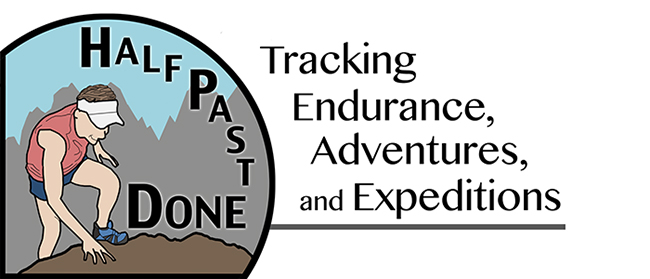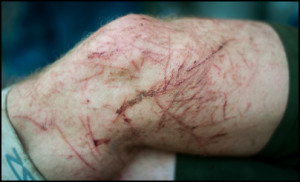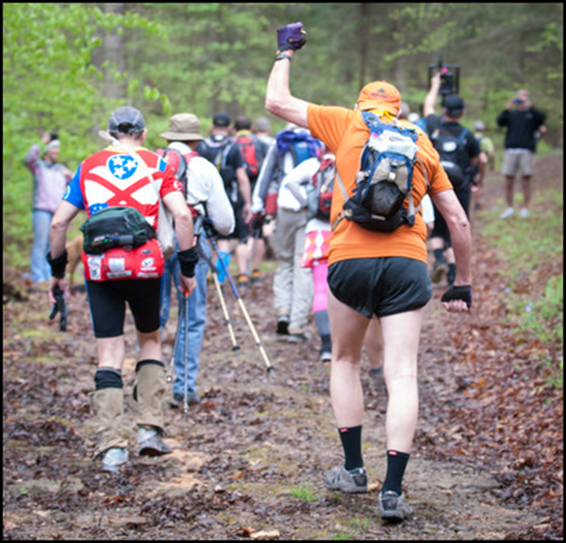
Stu Gleman fist pumps at the start of the Barkley Marathons. Photo © Geoffrey S. Baker, www.geoffreybakerphotography.com.
From the outside, the Barkley Marathons seem like joke — an over-the-top parody of all the ultrarunning events that take themselves much too seriously. One imagines a bearded race director puffing a cigarette on his back porch in the Tennessee sun, fuming over how two more people managed to finish his race again this year. “I know,” he exclaims with a cough. “Next year, we’ll make them carry a bag of feral cats the whole way. That’ll trip them up!”
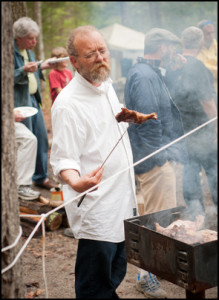
Lazarus Lake, Race Director of the Barkley Marathons held every spring in Frozen Head State Park in TN., checks the chicken dinner. Photo © Geoffrey S. Baker, geoffreybakerphotography.com.
Barkley appears to be that kind of race … the kind where only a bag of cats could make it any more ridiculous, or difficult for that matter. Even on paper, this series of five “twenty-mile” loops in Tennessee’s Frozen Head State Park qualifies as the most climbing-intensive ultramarathon in North America. The race boasts a reported 60,000 feet of climbing in a still-unknown distance that is definitely over a hundred miles.
Add to that trail-less navigation, orienteering, a scavenger hunt for book pages, raw chicken at the sole “aid station,” muddy terrain, prickly saw briars, temperatures that range from freezing to sweltering, and generally bushwhacking through the thick Southern woods for sixty hours without sleep while semi-lost and exhausted. And alone — no one is coming to the rescue when runners finally realize they’ve been punked. In nearly twenty years of Barkley Marathons, only fifteen people have finished, total, out of more than 800 runners who’ve tried. There’s a single, giant twenty-pound belt buckle available to anyone who can go sub-24 hours in the event; no one has yet broken 52. The race is even held on or around April Fool’s Day every year. It’s a terrible prank … and for that reason, runners seem to embrace the Barkley Marathons with serious passion.

Nicki Rehn celebrates on the summit of Prairie Mountain in early March. Photo by Jen Silverthorn.
Recently I caught up with Nicki Rehn, an Australian woman who lives in Canada, after she participated in the 2013 running of the Barkley Marathons. Nicki is one of a select few women aiming to become the first female to eventually finish all five loops at Barkley. An ankle injury prevented her from going into the race with full confidence this year, but she toed the line anyway in hopes of gaining a better understanding of the course — with an eye on hoped-for future attempts. She provided a few insights into this secretive event now that she’s been let in on the joke.
HPD: When did you first learn about Barkley? At the time, did you think was an event you were interested in?
I don’t know where I first heard about the Barkley — maybe two to three years ago. But I do know that I was interested in it from the very beginning. I bought Frozen Ed’s book and devoured it in one sitting. Now that I have been there, I am about to start reading it all over again. I also read all the blog posts on Matt Mahoney’s Web site, so you could say I have been a little obsessed about this race. I don’t think anyone goes into this race without being at least a little bit obsessed. With my background in multi-day adventure racing, Rogaining (a sport of long-distance cross-country navigation), solo fast-packing, and three years at Tor des Geants (a 200-mile mountain run in Italy), it felt like this race was created with me in mind.
HPD: What made you decide to apply for Barkley this year?
I was going to apply last year and started corresponding with Laz (Lazarus Lake, the race director). But at the last minute, I realized I had a wedding on the same weekend so did not submit my application. Getting into this race is hard, if not near-impossible, but you have to have your name in there to have a chance. Yes, the process is somewhat secretive. In 2011, I was sharing a tiny funicular car with a Belgian friend, Wouter, as we traveled over Mont Blanc. He mentioned that he was going to be doing the Barkley Marathons for the second time. I couldn’t believe I was actually spending the day with someone who had toed the start line of this mysterious race. At first he was reluctant to give up too much information, but eventually he gave me some tips for starting the application process. I guess I got lucky and a year and a half later, I found myself at the start line. It was like a dream.
HPD: What kind of emotions did you experience when you received that letter of condolence that you got in?
When I received my letter of condolence I went into a blissful shock for about three days. I was literally speechless. I was staying with my parents in Australia at the time and I got the letter at 5:30 a.m. I woke them up right then to tell them.
HPD: I understand you were battling injury leading up to the race. What happened and how did you try to work around it?
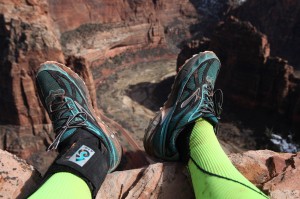
Nicki Rehn in Zion National Park in February, “Taking the busted ankle where the busted ankle probably shouldn’t go.”
Nine weeks before Barkley, I slipped on ice in the parking lot at work and did a third-degree ankle sprain. Ironically, the day before I had been out training in the mountains running repeats on icy, debris-covered cut lines. I was devastated. This really changed everything for me — the lead-up to the race and also my goals during the race. I’d like to say I did everything I could for fast healing, but I knew I had to try and maintain at least my base fitness. My friends all told me that my experience would carry me through, but I knew that it wouldn’t be enough. I spent a lot of time in spin classes and at the gym. Within three and a half weeks, I was able to limp up my local training mountain. I should have still been on crutches at that point, but I stubbornly battled through. I hiked as much as I could bear. It was pretty stupid but I was desperate.
HPD: Given your injury, did you go into the race with any specific goals? Or did you want to see what happened?
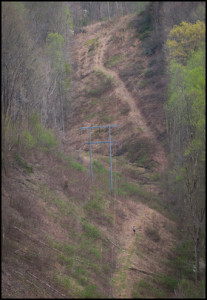
Wouter Hamelink, white shirt, lower right, approaches the “Testicle Spectacle” at the Barkley Marathons. Photo © Geoffrey S. Baker, geoffreybakerphotography.com.
It was hard to go into such a tough race so undertrained. I was ten pounds above my race weight, I hadn’t actually “run” in nine weeks, and my ankle was still another couple of months off being healed. There was no power in my infamous power-trek, and I felt like I had no business being at Barkley. But I decided to show up to Frozen Head State Park anyway and see how things went — start the “Barkely Project” as I like to call it. My goal was to do one lap, learn the course, meet the people, absorb the Barkley experience, not destroy my ankle, and try to win myself a spot back for next year.
HPD: What was your experience like in this year’s Barkley Marathons? How long you were out there? What made you decide to stop?
My experience was surprisingly positive. I took just over eleven hours to finish one lap and I loved every minute. I had a huge smile on my face the whole time. I was finally getting to travel the sections of this course that I had read about for so long. I expected Rat Jaw to be as bad as bad could be and I would have been disappointed if it wasn’t. I was not disappointed! It was exactly has I imagined it — the briars, the river crossings, the muddy butt-slides, the rain, the endless climbing and descending, the emptiness of the park. I kept saying to myself, “Look Nicki, you are doing the Barkley.”
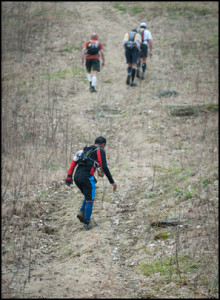
Iso Yucra, foreground, climbs the final pitch of the the Testicle Spectacle during the Barkley Marathons. Photo © Geoffrey S. Baker
I loved the navigation aspect and was most content when I was bashing through the woods on a compass bearing rather than running the “candy-ass trails.” Finding each book was a thrill. I spent some of the loop with a veteran (thanks to Chip Tuthill and Mike Bur) and some of it alone. My pace was conservative and I took extra time to really study the terrain as we passed through it. I got back to the yellow gate feeling strong and super excited, so I decided to head out on a second loop — at least to book two at the “eight-mile” point. It had started pouring with rain, it was pitch dark and freezing, and I wanted to practice leaving the comforts of camp under such miserable conditions. I did not have a crew so I spent about 45 minutes sorting myself out, cooking up some hot food and getting ready for the night loop. As I crested Bird Mountain, the famous Barkley fog rolled in. You couldn’t see a foot in front of you and I was about to drop off the backside of the mountain into the wilderness with nothing but a compass bearing to guide me. It was impossible to know where to leave the candy-ass trail to head down to the book. I tried twice but the angle of the terrain under my feet didn’t feel right. A mistake here would mean a long, cold night spent wandering aimlessly near the edge of the map, or hunkered under a rock in an emergency bivy. I figured it was a good time to pull the pin. My ankle had started bothering me and I had already exceeded my goals for this race. I got back to the yellow gate just after midnight and reported for my bugle concert.
HPD: Now that you’ve experienced it, how would you compare Barkley to other extremely difficult trail races such as Tor des Geants?
The only thing I can compare Barkley to is a multi-day adventure race or a Rogaine that goes for sixty hours instead of twenty-four. But even then, you have teammates and partners. In the Barkley, you are alone, “out there.” There is no support, no aid stations, no spectators, and very few athletes on course with you. I have finished Tor des Geants twice in three attempts, and even though it is a solo event, you never experience the aloneness that you get in Frozen Head State Park. I didn’t get far enough in the course to experience any kind of serious fatigue or sleep deprivation, so I can’t compare that part of it. With 60,000 feet of climbing in just over a hundred miles, it is on paper the most physically demanding race in the world, especially when you consider that much of the race involves bushwhacking and hauling oneself up muddy, briar-infested hillsides, sometimes on all-fours. I have definitely done sections of adventure races that are harder, but not for so long.
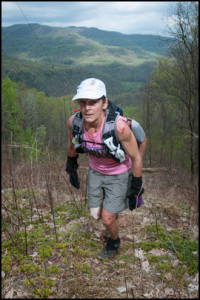
Beverly Anderson-Abs in the lead group on loop 1 at the Testicle Spectacle during the Barkley Marathons in 2012. © Geoffrey S. Baker
HPD: Do you think it’s possible to complete the full race in under sixty hours, for you or perhaps any woman?
To finish the full course under sixty hours is definitely in the space between the hardest thing I will ever do and impossible. I thought that determination, patience, strong navigation skills, experience with sleep deprivation, and an ability to suffer would be enough to get through it. But what I learned is that you also have to be fast. The time cut-offs are really tight. I have to believe that a woman can and will finish this race one day. It might not be me, but I’m going to give it my everything over the next twelve months to see if I can at least make a dent. With the correct training, I believe I can do the Fun Run (a completion of three loops of the course), and that might be the next step in my Barkley Project. But for sure, that elusive five-loop finish is just suspended there in my imagination and dreams.
But will I be back? It all depends on Laz and that “lottery.”
